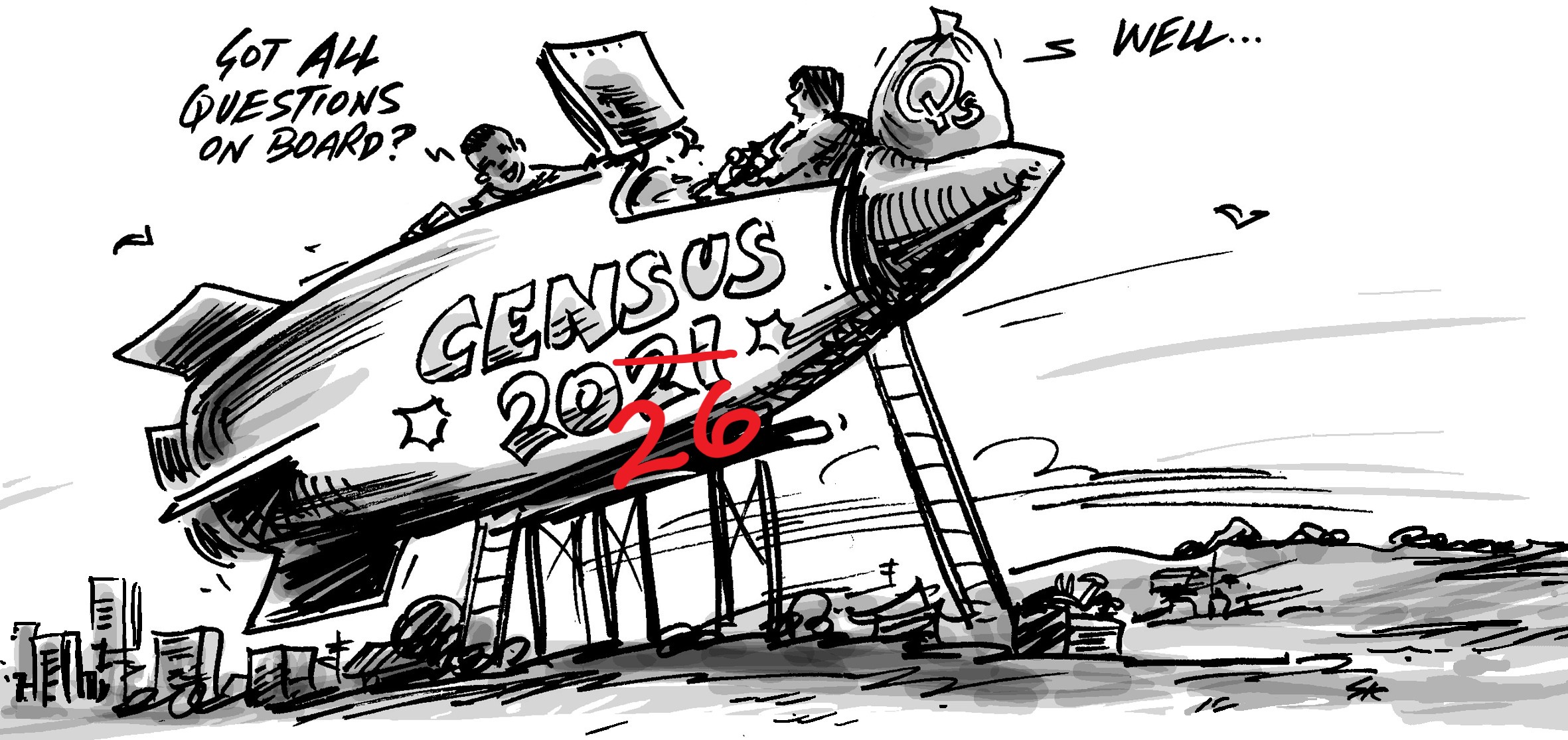In September last year, as the Census collection was wrapping up, I made 12 predictions about what the results would say.
In part, these were simply my dabbling in psychic prophecies and prognostications. However, I also drew on my exposure to the Census and Australian macro-demographic trends in the course of my day-to-day work with local governments across Australia.
Now psychics are notorious for making lots of predictions and never mentioning when they are wrong (or making the predictions so general they are bound to come true).
To stave off such scathing critiques of my own crystal ball gazing, I made some very specific predictions. And now, with the 2016 Census data in our hands, it’s time to revisit those predictions and see how I went.
1. Reduced Estimated Resident Population of Australia to 24,038,000.
My prediction
The ERP will approximately be around 24,038,000 – down by 100,000 from the pre-Census estimate. The Census and the Post-Enumeration Survey (which estimates how many people are missed) regularly revise Australia’s population, and I think the mining downturn will mean a slight reduction from the pre-Census estimates. In 2011, the population was revised down by more than 300,000.
Result: MISS
After the 2011 Census, the population of Australia was revised down by 300,000 people. But after the 2016 Census, it was revised UP by 83,000 people, and the ERP based on the Census (not the same as the Census count) ended up at 24,210,000.
2. More people missed
My prediction
The move to the primarily online survey and mailout, coupled with the Census website being offline on Census night, poor communication resulting in negative coverage on data privacy and security, and certain unhelpful politicians casting doubt on the Census will see the net undercount (the number of people missed in the Census) increase from 1.7% in 2011 to 4.0% in 2016. While this would not be a great result in Census terms, it will still provide a great deal of usable data down to small area level.
Result: PARTIAL HIT
I predicted a rise in the net undercount to 4.0%, due to the issues the Census had with the site going down, political involvement and all the negative publicity around Australia’s most important statistical collection. In actual fact, the net undercount went down to 1.0%, so in that way, this is a miss. However, I’m claiming a partial hit because in fact, the GROSS undercount was very close to 4%, and the net undercount only declined because of overcounting by imputing people into non-contact dwellings.
3. The rise of ‘No religion’
My prediction
With the change to the Religion question putting “No Religion” at the top, the proportion of people choosing this option will rise from 22.3% to 29.0%, overtaking Western Catholic as Australia’s largest single religious group. This is also influenced by the large influx of Chinese migrants, the majority of whom have no religion. Islam will rise from 2.2% to 2.6% of Australia’s population, but Hinduism will overtake it, at 2.7%, due to very large migration from India. Christianity overall will fall from 61.1% to 54.8% of the total population, but “Christian, not further described” will continue to rise to 3.5% of the population, becoming Australia’s 5th largest religious group. Despite calls not to do so, around 52,000 people will still put their religion as some variant of “Jedi”
Result: HIT
I predicted ‘No religion’ to rise from 22.3% to 29.0% of population. It actually rose to 29.9% of population, so marginally higher, but very close to my prediction, so I am claiming this one. There is a strong move away from religion in Australia, and the change in the question to place the “No religion” response at the top also had an effect. I was a little off with the growth in Christian NFD, which did rise, but only to 2.6%, and Hinduism remained below Islam at 1.9% of population.
4. Changing migration
My prediction
The largest growing birthplace groups from outside Australia will be China and India, both increasing by nearly 50% to over 400,000 people each. With many Kiwis returning home, New Zealand migration will not grow as fast but will still be the 2nd largest group after the UK. In percentage terms, people from Pakistan will be the fastest growing group (of the larger countries), more than doubling in number from 30,000 to over 60,000. Large increases will also occur from Iran (+70%) and Nepal (+60%). We are also seeing a return in migration from Ireland, so expect the Irish to increase by about 25,000 or 40% as well. The tiny nation of Bhutan will have a large increase in percentage terms as well, adding about 2,000 people or over 100% increase in their current population in Australia.
Result: HIT
Both China and India rose by close to 50%, and are both over 400,000 (China is over 500,000) Australia-wide now. New Zealand remains the second largest overseas-born group as predicted, but only just ahead of China. Pakistan grew almost exactly in line with my prediction, doubling to 61,000 people. People from Bhutan continued to grow, to almost 6,000, while people from Nepal more than doubled to 54,000, outstripping my prediction by a bit. Ireland, however, grew by only 8,000 people, so a bit less than the prediction. But overall, pretty close.
5. Rentals Rise, home ownership falls
My prediction
Large housing price increases will see an increase in the proportion of households rented in capital cities, from 28.8% in 2011 to 30.6% in 2016. There will be a corresponding fall in full home ownership from 29.3% to 27.8% and fall in mortgage holders from 35.1% to 34.1%. In contrast, regional areas will see a rise in mortgages to 33.0%, while rented dwellings will be stable at 28.5%.
Result: PARTIAL HIT
I predicted a rise in rental to 30.6%, and a fall in home ownership to 27.8%. The actual figures were 30.9% and 27.5% so that’s pretty close! Home ownership fell to 31.0% of all dwellings. I also predicted a rise in mortgages in Regional Australia which wasn’t so close. Regional mortgages are actually lower than metropolitan, due to high full home-ownership in these areas.
6. Growth in cities
My prediction
Population will shift back to the cities – 80% of the 5-year growth in Australia will be concentrated in Greater Sydney, Melbourne, Brisbane, Adelaide and Perth. Previously fast-growing coastal areas outside the capitals will show slower growth in the 2011-2016 period.
Result: HIT
I said that 80% of population growth over five years would be concentrated in the Greater Capital City areas. The actual figure was 78%, which is very close. Only 22% of all the 1.9 million growth in population between 2011 and 2016 was in regional areas of Australia.
7. Housing for young adults
My prediction
25-34 year olds will be particularly affected by housing affordability. The proportion living in dwellings with a mortgage will drop from 39.7% in 2011 to 35.0% in 2016. Correspondingly the proportion renting will rise from 43.3% to 46.5%.
Result: HIT
I said 25-34 year-olds with a mortgage would drop from 39.7% to 35.0% in 2016. The actual figure was 35.2%, so I think this is about my most accurate prediction!
Certainly a big drop as it’s harder to get into the housing market. The proportion renting did go up, but not as much as I predicted, sitting at 43.6% in 2016. The difference was actually absorbed mainly in the “Not Stated” category, the larger size of which is a consequence of the poorer quality of this Census with more imputed dwellings (as prediction 2).
8. Australia’s largest industry
My prediction
Following changes in the past 3 Censuses, Health Care and Social Assistance will remain as Australia’s number 1 employing industry in 2016, employing more than 1.4 million people. Manufacturing (which was the largest employer in 2001 and earlier) will drop back further to 880,000 people.
Result: Unknown
This is part of 2nd release Census data, coming out in October. We’ll publish a new blog revisiting these predictions then!
9. Higher education
My prediction
We continue to become more educated. The proportion of Australians with a Bachelor Degree qualification will top 1 in 5 for the first time, reaching 21.5% in 2016.
Result: Unknown
This is also part of 2nd release Census data. Stay tuned!
10. Stable household size
My prediction
Australia’s average household size will continue to be stable at 2.55 people per dwelling. Declines in regional areas will be offset by small increases in metropolitan areas.
Result: HIT
To three decimal places, the average household size for Australia remained the same, at 2.55 people per occupied dwelling in 2016. Modest increases in some metropolitan areas were offset by declines in outer suburban and regional areas. Western Australia after having the largest increase in household size from 2006-2011, dropped back a bit in 2016, after the mining boom ended.
11. Overseas exclusions
My prediction
Approximately 1.2 million Australians overseas on Census night will not be included in the Census. These are not part of the undercount as they are out of scope for the Census and are factored back into the ERP using Passenger Cards.
Result: MISS
I predicted a record 1.2 million people overseas and not counted in the Census. The actual figure was 632,000 (just over half of what I predicted). So I can’t claim this one!
12. The impact of the Rio Olympics
My prediction
The number of people with “Sportspersons” and “Sports Coaches” occupations, and “Instructors and Officials” will drop by about 5% and 2% respectively. This is due to the number of athletes and support staff at the Rio Olympics, which covered the Census period. In 2011 there were 7,862 Sportspersons and 28,825 Coaches and Officials in Australia. So the few hundred at the Olympics will have a small impact which may be offset by population growth. The Olympics coincides with Census every 20 years.
Result: Unknown
Unfortunately, once again, ‘Occupation’ is a variable we learn about in the second release of Census data. Check back in October!
My Scorecard
So, overall, I count 5 hits, 2 partial hits, 2 misses, and 3 unknown until we get the final release of data!
This is just a bit of fun, but it does underline the fact that we already know a lot about our communities, and often Census data can serve to reinforce what we already know, or perhaps dispell some myths.
The community profile resource is designed to let you do this same exercise, in your community, at the local level.
At the time of publishing, we are working to update the community profile tools for all our clients in Local Government across Australia. So far, we have released the first data sets for primary areas, and will be rolling out more updates in the coming weeks. Our update tracker is the best place to keep up-to-date with the latest releases.

.id is a team of demographers, urban economists, spatial planners and Census data experts who use a unique combination of online tools and consulting to help governments and organisations plan for the future. Access our free demographic resources here.










